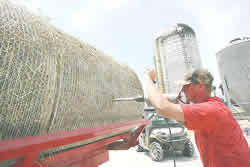 The Feldun Purdue Agriculture Center, northwest of Bedford at the end of State Road 458, has been a part of the Purdue Agriculture System since 1914, and is the oldest farm in the system. The 1,180-acre operation has had many features over the years, including an apple orchard, a herd of dairy cattle and flocks of sheep and chickens. Today its main emphasis is on beef production. The Feldun Purdue Agriculture Center, northwest of Bedford at the end of State Road 458, has been a part of the Purdue Agriculture System since 1914, and is the oldest farm in the system. The 1,180-acre operation has had many features over the years, including an apple orchard, a herd of dairy cattle and flocks of sheep and chickens. Today its main emphasis is on beef production.
“The big item at the farm is the Indiana Beef Evaluation Program, also known as the bull test station,” said Brad Shelton, manager of the center. “We develop 250-300 bulls annually. They are delivered as weaned calves, placed on test for five months, and then those that are in the top two-thirds of their breed in performance, are structurally sound, and pass a breeding soundness exam, are sold at the Springville Auction Market with an IBEP brand.”
He added that the center also calves out 250 cows each winter and breeds about 300 females each spring.
A current project with the cow herd is comparing a two-breed rotation to a composite herd. The two-breed rotation is breeding Angus cows to Simmental bulls and Simmental cows to Angus bulls. The composite herd is a Simmental-Angus (Sim-Angus) cross. The purpose is to determine how much heterosis (an improved quality or increased function of any biological quality) is lost by not following a traditional two-breed rotation.
“In order to speed the process of datacollection for the cow herd and the bull test station, Feldun uses a fair amount of technology,” said Shelton. “Each cow, calf and bull on the farm receives a RFID (radio frequency identification) button, in addition to a visual ID tag, either at birth for the calves or at arrival for the weaned bulls entering the bull test station. This allows the use of a Bluetooth-type wand to be placed near the button in the animals ear. The wand will send a signal to the button and upon picking up the return signal the wand will send the identification number to the computer. The computer will then pull up all the information on that particular animal be it all the previous weights, frame score, calves the cow has raised, average daily gain, etc.”
Once the information is on the screen and the scale has balanced, a button on the scalehead is pushed and the weight is automatically recorded in the database and the animals history is updated. Feedsheets for the bull test station are all computerized as are the feed sheets for the dairy heifer project.
“We still calculate by hand when the power is out or the computersare down but the technology generally speeds up the process of calculation and data analysis,” Shelton added.
A second project with the cowherd is the examination of the long-term effects of a couple of commonly used indexes when selecting bulls, $W and $B. According to Shelton, breed associations have more or less overwhelmed cattlemen with development of various EPD’s (Expected Progeny Differences) that they created an index to try to simplify bull selection. An EPD basically looks at the parentage of a particular animal and predicts how much it will weigh at a certain stage in life, how much milk its offspring will produce, how it will grade (size of carcass, size of the ribeye steak, and marbling) when hanging on the rail. An index take into account the various EPD’s and then factors in a dollar amount, which is the bottom line for a producer.
“The most important index can depend on where a person falls in the process,” Shelton said. “What we don’t know is the longer term effects on the cow herd. Most producers are selecting animals that have a high $Weaning or high $Beef index when sending the steers to the sale barn or feedlots and looking at the money we make there. However, we’ve not really examined the long-term effects on the heifers kept in the cow herd. It’s possible that while we’re making more money with larger weaned calves or a heavier carcass hanging on the rail, we are creating a larger, inefficient cow that will eat the extra revenues in the form of hay and pasture.”
The newest project at Feldun is the development of dairy heifers.
“We’ll have a group of up to 16 holstein heifers at any one time,” he said. “The heifers come in at about 225-250 pounds and we’ll feed them a grain and hay ration until they are 28 weeks of age when will leave weighing about 500-600 pounds. Half will get one type of grain mix and then other will get a different type of ration. We’ll cut back on grain as they grow and increase the amount of hay. The purpose is to determine how much they can eat daily, how quickly they gain weight, and to determine how their rumen (the first chamber of the digestive system) develops as they age with the different rations.”
Other recent projects have been related to fly tag research and rotational grazing. The fly tag project focused on the effectiveness of certain insecticides embedded into ear tags used on cattle against horn flies and/or face flies. The grazing project compared a more traditional two paddock rotation versus an eight or nine paddock pasture system to evaluate weight gain and number of days grazing, versus the number of cattle grazing.
The center has four employees who work with the cattle and a fifth part-time employee who takes care of the grounds. |